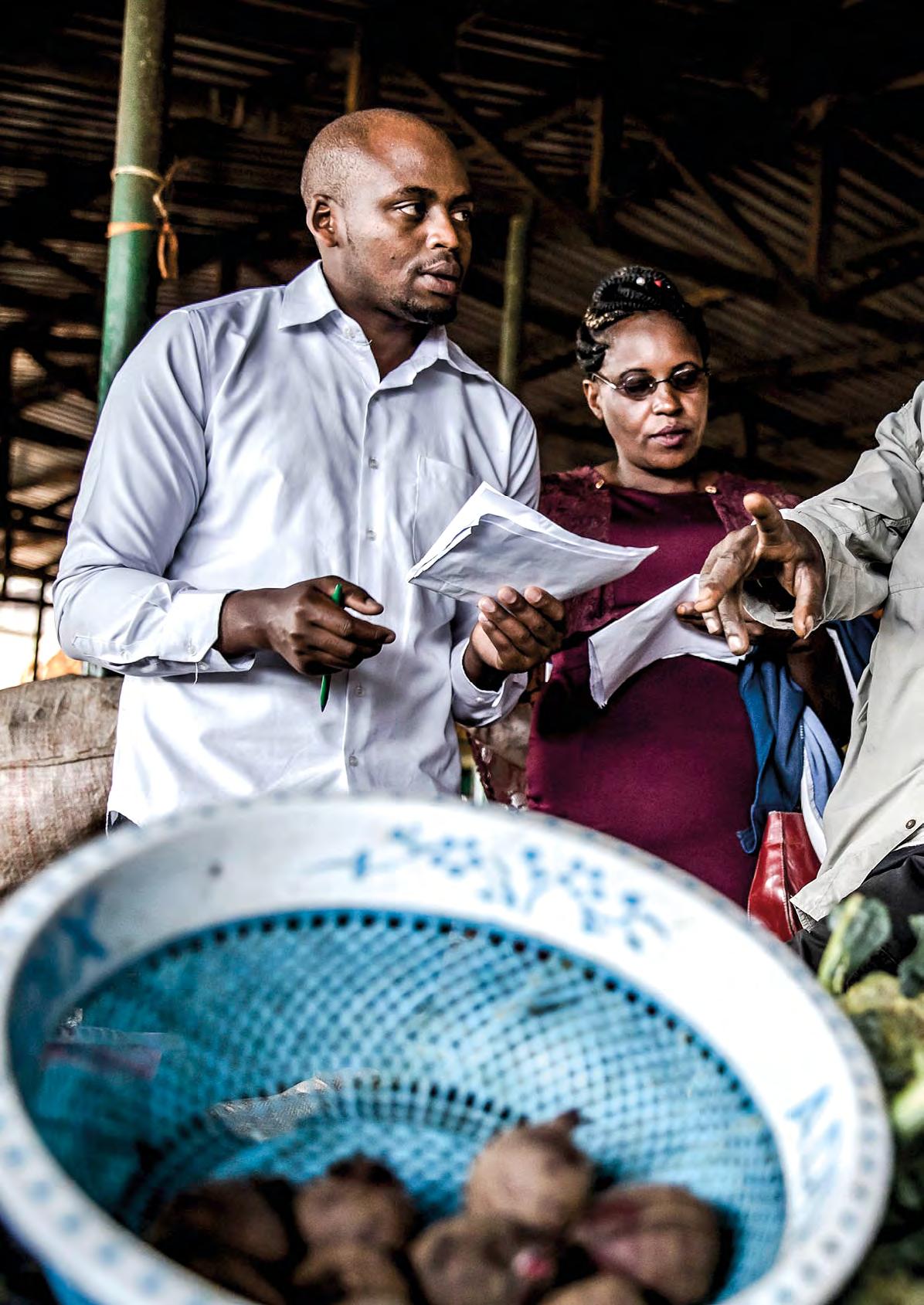
16 minute read
Lever: Ensure equitable access to quality public services
Citizen engagement for better public services in Ethiopia
Serkalem Tafesse

The Ethiopia Social Accountability Program (ESAP) has set in motion a new way of engagement between citizens and public officials to improve the delivery of basic services that are crucial for local socio-economic development. This is particularly important in the Ethiopian Highlands, where basic services have been inadequate and have not met people’s specific needs.
Despite a long history of statehood, Ethiopia has deep-rooted socio-economic and governance problems. Access to basic service delivery is still a serious challenge to many Ethiopians, particularly in rural areas of the country. The Ethiopia Social Accountability Program (ESAP) is a countrywide programme that aims at strengthening local-level social service delivery in five sectors: education, health, water and sanitation, rural roads and agriculture (Box). Now in its third phase, ESAP has partnered with 76 civil society organizations to support local community-based organizations in becoming more knowledgeable about service delivery and in providing guidance on holding public officials accountable for the quality delivery of services. During its second phase, Social Accountability Committees (SACs) were established at the village and district levels. These facilitated processes with a wide range of community members, particularly members of vulnerable groups, to identify priorities for improving public social services and developing joint action plans (JAPs) that respond to the local needs of the different social groups (Figure 1). This is of particular importance to Ethiopia’s highlands with their specific socioeconomic and environmental conditions.
Machakel district in the highlands of Amhara region (between 1 500 and 2 000 m asl) is one example where ESAP is active. It is home to about 143 000 people, more than 80 percent of whom depend on agriculture as their main livelihood. In the 1990s and 2000s the population declined by more than 30 percent [1]. A rapid assessment conducted by ESAP in 2015 revealed that 88 percent of the communities were previously not involved in the planning, budgeting or implementation of basic public services, nor in the monitoring of their quality, accessibility and equity standards. Only 28 percent of citizens had access to quality agriculture services and 17 percent were satisfied with their access to agricultural inputs [2].
Experimental planting of crops by farmers in Machakel district (ESAP)
“ The [Machakel] woreda has become a model for East Gojjam zone, because it is making agriculture services equitable, effective, efficient, responsive and accountable. Many NGOs usually come up with cash and give us something in terms of a handout which is consumable. This project is changing the attitude and raising the awareness of the community and the awareness of service providers, which goes a long way.”
Ato Tariku Tadesse, Machakel District Finance Head and SAC secretary
Farmers in Machakel district visiting the improved Farmer Training Centre (ESAP)
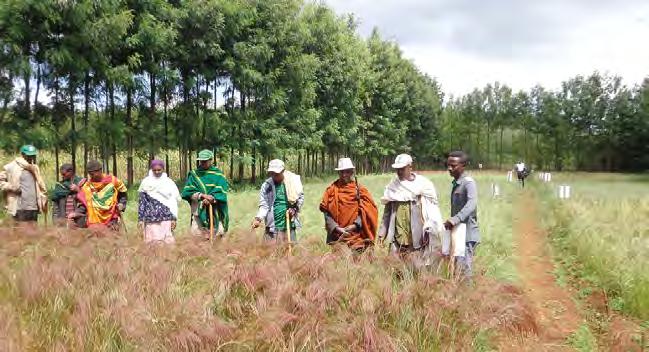
The social accountability process in Machakel started in 2015 by teaching citizens and service providers in the agriculture sector about the government’s service standards. Several focus group discussions involving women, people with disabilities, youth, vulnerable groups and poor people revealed that the Development Agents and the Farmer Training Centre (FTC) were not providing adequate support to farmers. Seeds and fertilizers were distributed with delay and without consideration for the specific conditions of the highlands, causing declines in productivity. At an ensuing interface meeting in 2016, the community and district agricultural bureau agreed on the following improvements: • To give farmers access to FTC land with the purpose of testing the suitability and productivity of different seeds and fertilizers before planting them on their own land; • To address the lack of a veterinary clinic. The district authority agreed to appoint a veterinarian and purchase drugs, while the community agreed to contribute in cash and labour to set up a clinic.
These participatory processes helped to empower citizens and resulted in improvements in basic service delivery. The existence of the programme seems to have altered how local governments provide basic services, although there is as yet no conclusive evidence that these improvements can be exclusively attributed to social accountability activities. Now, communities generally report greater satisfaction in the functioning of services, and people perceive fewer frontline service delivery problems, such as availability of textbooks in schools, timely provision of select seeds and fertilizers, medicines in health care and timely access to nurses and doctors. ESAP’s most significant achievement is the establishment of platforms for citizens and public officials to have constructive dialogue about issues that matter to them. • Fostering social accountability through citizen engagement helps to improve services. This means paving the way for citizens to influence local decisionmaking by engaging them in planning, implementation and monitoring. Collecting their feedback throughout this process is vital. • Excluded and vulnerable community groups, such as people with disabilities, must be represented in the social accountability process and their needs taken into account in decision-making. • For social accountability to be sustainable, it needs to involve existing structures such as parent–teacher–student associations, WASH committees and farmer associations. ESAP3 is setting the stage for this by shifting from using parallel structures to working with existing structures that will continue to exist without the need for external support.
Ethiopia Social Accountability Program (ESAP)
ESAP started in 2006 as a pilot and is in its third phase (ESAP3, 2019–2023), reaching citizens and local government in 317 woredas (districts). It is supported by a multidonor trust fund administered by the World Bank, based on an agreement between the government of Ethiopia and the European Union, Ireland, the United Kingdom, Austria and Sweden. ESAP is managed by a management agency that oversees implementation by local civil society organizations.
Figure 1. Process to assess and improve social service delivery through involving different stakeholders at the community and district levels
Facilitates national learning and experience sharing
ESAP Management Agency
Capacity building, grant management, monitoring
Civil society organizations (CSOs)
Establish and support
Facilitates national learning and experience sharing
Social Accountability Committee at district level
Members: community leaders, elected officials, service providers
Social Accountability Committee at community level (these are being replaced by existing structures such as WASH committees and farmers’ associations under ESAP3 as part of the sustainability strategy)
Members: representatives of citizen groups, elected officials, service providers Facilitate with guidance from CSOs and monitor implementation
Joint action plans (JAPs) for improved service delivery developed in “interface meetings”
Participants: service providers (e.g. health, education), community leaders, council representatives
Community priorities for JAPs identified through community score card and focus group discussions
Participants: different members of the community, particularly women, elders, youth, people with disabilities, people living with HIV/AIDs, etc.
Modernized administrative services for Armenian citizens
Vardan Janazyan and Lika Mkrtchyan
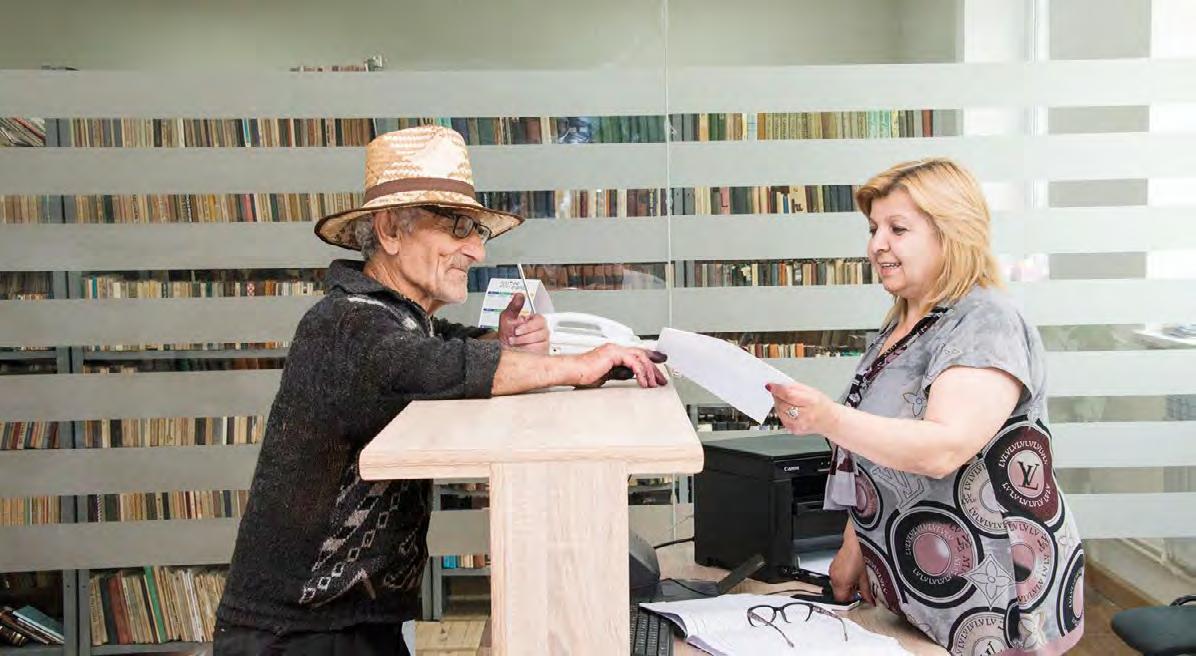
Armenia, a mountainous country, has been consolidating its previously fragmented – and thus ineffective – municipal landscape. Newly established “Citizen Offices” serve as municipal operation hubs and are equipped with a Municipal Management Information System to enable the exchange of data. As a result, nearly half of the country’s population outside the capital, Yerevan, can now benefit from modernized, transparent and efficient access to municipal administrative services.
The Republic of Armenia is mountainous, with steep slopes and deep river valleys. The country’s topography and environment has influenced its population distribution as well as its historical, political and socio-economic situation. About threequarters of Armenia’s population live in mountainous areas [1, data from 2015]; 23 percent of people live below the national poverty line and 17 percent are unemployed [2, data from 2018]. The challenging economic situation has long led to high emigration.
In 2015, Armenia had 915 municipalities of greatly varying population size. The municipal landscape was highly fragmented and many municipalities were too small to fulfil their functions effectively. In response, the government launched the Territorial and Administrative Reform of Armenia (TARA). TARA’s goal was to reduce the number of existing municipalities and support effective decentralization to provide better services to their citizens and businesses, make efficient use of the limited financial resources and support sustainable socio-economic development. By March 2020, 465 former municipalities had been merged into 52 multisettlement municipalities. The government foresees full implementation of the reform by the end of 2021, with the number of municipalities reduced to 150–200.
The resulting – much larger – municipalities are establishing “Citizen Offices”, to deliver modernized, transparent and efficient administrative services to the local population. Establishment of the Citizen Offices is part of a broader programme by the Ministry of Territorial Administration and Infrastructure, funded by Switzerland and Germany and implemented by GIZ, the Council of Europe and UNDP [3, 4]. The programme aims at strengthening accountability, effectiveness, efficiency and inclusiveness of local self-government bodies. In this regard, improved service
Zhora, one of the oldest citizens of Tumanyan municipality, benefits from the proximity of administrative services (Good Governance for Local Development, South Caucasus)
“ We can immediately provide a reference number for any enquiries received from our inhabitants here. Through the Municipal Management and Information System (MMIS) the citizens can then track and follow their requests online. And there is no further need for citizens to go to the centre.”
Iveta Mirzoyan, MMIS Operator, Mets Ayrum settlement of Akhtala municipality
Rugged valleys and scattered settlements in Lori Province, Armenia (K. Faljyan/shutterstock.com)

delivery by municipalities and enhanced citizen participation in local governance, including empowerment of women, are of particular importance.
The Citizen Offices operate following the “single window” principle and serve as a hub for municipal operations. They are equipped with a web-based Municipal Management Information System (MMIS) to ensure the seamless exchange of data among local, regional and national authorities. The official municipal websites are also operated through MMIS, enabling not only access to a variety of services online, but also a say in various planning and budgeting processes. For example, citizens can participate in municipal planning and budgeting processes, and access up-to-date information on annual/multiannual development plans as well as mayoral/local council decisions. Citizens can also file tax returns (e.g. land and property tax, local duties, other fees), submit and track applications online, consult the online guides and ask questions. Accordingly, the official municipal website is the first port of call for citizens seeking information that they are entitled to under the Freedom of Information law. Moreover, the website allows the municipality to conduct citizen satisfaction surveys online.
In 2020, nearly half of the population outside the capital had access to improved administrative services through 49 Citizen Offices and MMIS that were not only introduced in all consolidated municipalities but also in about 80 municipalities that have not yet been consolidated. Citizen Offices have made it much easier and more efficient for citizens to deal with the authorities – and for public servants to carry out their work. A 2017 survey showed that 97 percent of the respondents were satisfied with the service provision, while 93 percent of the municipal staff said MMIS had considerably facilitated their work.
In April 2019, amid the decentralization of power and functions, the Armenian government delegated more than 60 state administrative services to the municipalities that operate a Citizen Office, enabling citizens to receive both municipal and state services in one location.
In 2015, a Citizen Office was established in Tumanyan, a 4 100-strong municipality of seven settlements. Located 150 km north of the capital at an elevation of about 800 m asl, Tumanyan is surrounded by mountains of over 2 000 m asl. “Grandpa” Zhora is one of the municipality’s oldest inhabitants. Sceptical about the merger of municipalities at first, he was pleasantly surprised at the positive results: “Night lighting has been repaired here – this means I can spend more time in my garden, especially at the height of cultivation season. The Citizen Office is near my house, so I go in person to pay the land tax. Processes are faster now, and the staff members know me and do their best to assist me.” • Strong government ownership in tandem with well-coordinated donor assistance is a prerequisite for the sustainable implementation of a complex reform such as Local Self-Governance (LSG). • Harmonization and alignment between capacity building of municipal staff and investments in infrastructure are important factors in achieving tangible, broad-scale improvements in public service provision and local economic development. • The success and pace of the LSG reform depend on well-targeted, consistent and continuous communication between the central and local authorities.
Zhora in his garden (Good Governance for Local Development, South Caucasus)
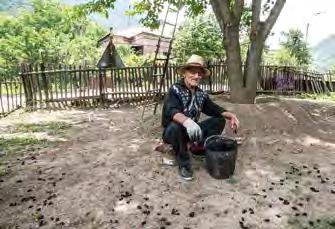
Addressing health care shortages through social innovations in the Bernese Oberland
Pascal Tschumi and Heike Mayer

Doctors and medical support are in short supply in Swiss mountain regions. Addressing this issue has led to innovative solutions based on novel forms of cooperation among local actors from the public, private and non-profit sectors. Not only do these social innovations respond to an urgent need, they can also contribute to regional development in the longer term, as they keep the area attractive for residents and enterprises. We present four examples from the Bernese Oberland in Switzerland that address the widening gap in health care service provision in mountain regions.
As a result of national trends such as rising health care costs and falling numbers of general practitioners (GPs) and other skilled workers, the supply of health care has become a problem in almost all Swiss mountain regions. While rural areas in general are affected, the mountains, disadvantaged by their remoteness, are particularly hard hit: residents as potential patients and health care workers tend to be drawn to urban centres, where health care services are better. In addition, the generally small budgets of mountain municipalities are strained by higher health care costs of an aging population. In the cases we examined, health care service providers and civic actors have initiated a range of innovative solutions to tackle the challenge of providing health care services in their area. In some cases, the public sector has played a supportive role. All of the solutions involve novel forms of cooperation between actors, most of whom have never worked together before nor been involved in health care. As such, these solutions represent social innovations.
Four examples from the Bernese Oberland in Switzerland are particularly relevant for addressing the widening gap in health care service provision: • The Frutigland Rescue Service Foundation (Stiftung Rettungsdienst Frutigland) supports the ambulance service of the regional hospital by funding and helping to train paramedics. The funding is organized through charitable donations to a foundation and covers personnel costs as well as some of the infrastructure.
It was established by engaged citizens in 2000 following the closure of the ambulance service, which for financial reasons was merged with more centrally located ambulance services. • The second social innovation is a GP emergency centre in the Thun area (Hausarztnotfall Region Thun), founded in 2010 by a group of GPs from the Bernese
Poster illustrating the protest against health care shortages in the Simmental, 2010 (Simmental Zeitung)
Bernese Oberland
The Bernese Oberland lies in the southern part of the Canton of Bern, between 500 and 4200 m asl and just north of the Swiss Alps. More than 200 000 people live in more than 70 municipalities in an area of about 2900 km2. Its main industry is tourism, attracting over 2 million visitors per year; it also has a strong construction industry.
Small communities in mountain regions face demographic changes and challenges in health care provision (H. Mayer)

Oberland. The emergency centre helps to coordinate the periods in which the
GPs are legally required to provide emergency assistance, helping to decrease their workload and thus making this type of work more attractive. • In 2015, the regional hospital in the municipality of Zweisimmen closed its maternity ward, mainly to save costs. Shortly after the closure, nearly 50 local citizens took action to fill this gap and in January 2017, the Geburtshaus Maternité
Alpine was opened. This privately-operated birthing facility is organized as a cooperative, which encompasses more than 300 members. It is financed by the members, donations and the revenues from birth services it provides. • A more general approach is taken by the Integriertes Gesundheitsnetzwerk Simmental–Saanenland, an “integrated health network” for two adjoining valleys of the Bernese Oberland. Founded in 2018, its purpose is to secure health care provision in the Simmental and Saanenland valleys by setting up a network among relevant actors, widening the range of services at the regional hospital and establishing a new health care centre. A broad set of actors such as the regional hospital operator, the cantonal director of public health and local mayors are involved in developing the network.
These novel forms of cooperation led to solutions that had never before been implemented in the Bernese Oberland. As they tackle the same challenge, they generate value for the region as a whole, not just for the actors involved. This value manifests itself economically and socially, contributing to regional development. The availability of local health care services and infrastructure reduces travel time for residents needing a service, as well as for skilled personnel required in the case of emergency. This helps the region to retain its attractiveness to existing residents, newcomers and health care personnel. To achieve sustainable regional development, it is vital that policy-makers consider social innovations. It is nonetheless important to remember that social innovations in health care in mountain regions, while highly useful, do not replace or substitute a certain level of general health care services. The public sector is still very much needed; in our examples, government actors play an important role in supporting the innovations.
Social innovations in the Bernese Oberland
A social innovation consists of new forms of cooperation at individual or organizational level that lead to new ideas, the implementation of which is at least considered. In the context of regional development, such innovations can have a positive impact on society, improve the quality of life and/or change social or power relations [1]. We found that the 68 social innovations we identified in the Bernese Oberland involved many sectors, ranging from health care to tourism and agriculture. Details are provided in our publicly accessible inventory [2]. • In the case of the Bernese Oberland, the enabling factors to successfully implement the social innovations included an openness to work together and willingness to find suitable organizational ways to secure a minimum standard of health care supply. • Social innovations are an effective means of addressing critical shortages in health care supply. They comprise novel forms of cooperation and bring together various actors from the public, private, nonprofit and civic sectors. They have the potential to create place-specific solutions to shortages in health care supply. • Social innovations can contribute to sustainable regional development by focusing on positive outcomes for mountain regions. They should be seen as ways to incorporate various interests and capabilities, but not as substitutes or an excuse for the public sector to withdraw from peripheral regions.
Public meeting to inform the local population about the Integrated Health Network of Simmental–Saanenland, October 2019 (N. Sager)
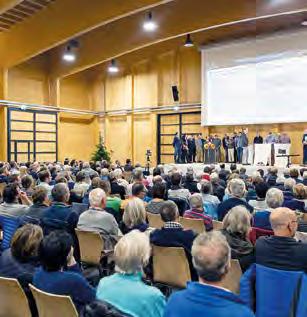
“ Trust has been built within the region. The pressure on all actors is high. The project can only succeed if everyone stands together.”
Pierre-Alain Schnegg, Government Councillor of the Directorate of Health, Social Affairs and Integration of the Canton of Bern, presenting the Integrated Health Network of Simmental–Saanenland during a public meeting [3].
